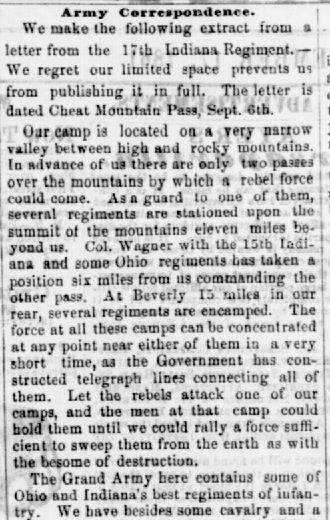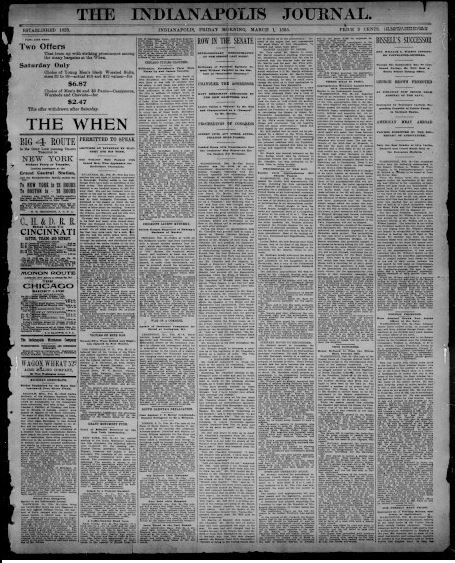The Evansville Daily Journal of Vanderburgh County was established in 1834 by William Town but did not appear as a daily until 1848, a year after Evansville was recognized by official charter as a city of Indiana. Town relocated to Evansville from the east and worked as both a grammar school teacher and printer. In March 1834, he disseminated the first issue of the Evansville Journal and General Advertiser, which was a pro-Whig (later Republican) paper. He remained the newspaper’s owner until his death in 1839.
William H. and John J. Chandler became the joint owners and editors of the paper in 1839. Under their management the paper was published as the Evansville Journal and Vanderburgh Advertiser. The title was eventually shortened to Evansville Journal. A year later John left the paper and his brother William became the sole owner, publishing the paper under the firm name of WM. H. Chandler & Company. William Chandler debuted the Tri-weekly Journal in 1846 and the Evansville Daily Journal in 1848.

In 1848, Addison H. Sanders purchased the Journal from William Chandler. Sanders oversaw the increased circulation of the Journal throughout southwestern Indiana between 1849 and 1856. He focused on improving the city department portion of the newspaper. The expansion of the paper paralleled the economic growth of Evansville during the 1850s, when the population of the city grew to 4,700. White newcomers were attracted to jobs with railroad firms, saw mills, and factories. Free blacks living in Evansville (about a hundred) also held both skilled and blue-collar jobs despite being barred from coming into Indiana in 1851 by Article XIII of the state constitution.
In October 1856, the Journal passed to Francis Y. Carlile. By April 30, 1858, Carlile had partnered with Indiana printers Frank M. Thayer and John Henderson McNeely. They formed the Evansville Journal Company (later Evansville Journal-News Company) and started to publish the paper under the name of that firm. Among the improvements the new proprietors made to the newspaper office was the installation of a steam engine and power press. Before more improvements could be made the newspaper office was destroyed in a fire. Its proprietors immediately arranged for the Journal to be printed from another newspaper office until it could be relocated. The company ultimately purchased a building located on Fifth Street between Main and Sycamore.
Carlile left the Journal in November 1859, selling his interests to James H. McNeely. By 1860, Evansville was the third largest city in Indiana behind Indianapolis and New Albany with a population of 11,484. Under the maintenance of the McNeely brothers and Thayer the Journal advocated for the election of Abraham Lincoln for president and unflaggingly supported the Union side during the Civil War.

John W. Foster purchased the interest of James McNeely and replaced him as partner in June 1866. Edward Tabor, a former bookkeeper for the paper, subsequently joined Frank M. Thayer, John McNeely, and John W. Foster as a partner in the Evansville Journal Company. In 1869, the Journal reported a circulation of 2,000 for its 8-page daily issues and 5,000 for its weekly issues.
Claude G. DeBruler purchased Foster’s interest and replaced him as partner in November 1872. Thayer left the Journal in 1883. James McNeely purchased DeBruler’s interest in 1885 although he had been listed in the newspaper as a proprietor since 1883. Following the departures of Thayer and DeBruler as well as Tabor’s death, the McNeelys became the joint owners of the Journal in March 1885. By 1889, James McNeely was editor-in-chief while his brother John fulfilled the role of river editor. Jessie McDonald (later Mrs. William Torrance) eventually oversaw the society department of the newspaper.
The Journal published a “Colored News” column in or near the want ads section between the early 1890s and 1909. The column had a black editor and covered goings-on in the black community such as church events as well as illnesses and funerals. Outside of the short, segregated column the newspaper’s derogatory tone towards blacks reflected the intense racial bigotry that affected the city’s black population, which at 7,405 approximated that of Cleveland, Ohio.
During the McNeely brothers’ maintenance of the Evansville Journal-News Company the circulation of the Journal grew to 9,844 for daily and Sunday issues, which were 8 and 16 pages respectively, by 1900. That was more than the Evansville Courier the Journal’s pro-Democratic competitor, which had a circulation of 8,555 for dailies 10-20 pages and Sunday issues 24-36 pages, in the same year. By 1920, the Journal had a circulation of 15,765 for week-days and 12,232 for Sunday issues. The Courier surpassed the Journal that year with a circulation of 23,893 for week-days and 20,978 for Sunday issues.
In 1923, the McNeely brothers sold the Journal to the Evansville Courier Company. The Courier office published its Sunday edition together with the Evansville Journal as the Sunday Courier and Journal between June 24, 1923 and 1936. The Evansville Courier Company suspended the Evansville Journal in November 1936. The newspaper’s masthead displayed slightly different titles over the course of its run including the Evansville Daily Journal, Daily Evansville Journal, Evansville Journal, Daily Journal, and the Evansville Journal-News. A former city editor at the Journal during the 1880’s characterized the paper as “a power in the republican party of the state” that supported the elections of several Republican candidates for state and federal offices including Benjamin Harrison (Senator from Indiana 1881-1887; President 1889-1893) and Charles Warren Fairbanks (Senator from Indiana 1897-1905; Vice President 1905-1909).
Books:
Bigham, Darrel E. We Ask Only A Fair Trial: A History of The Black Community of Evansville, Indiana. Bloomington & Indianapolis: Indiana University Press, 1987. Published in association with the University of Southern Indiana.
Bigham, Darrel E. An Evansville Album: Perspectives on a River City, 1812-1988. Bloomington & Indianapolis: Indiana University Press, 1988.
Esarey, Logan. History of Indiana from its exploration to 1922. Rochester, Indiana: Tombaugh Publising House, 1981.
History of Vanderburgh County, Indiana, From the Earliest Times to the Present, With Biographical Sketches, Reminiscences, Etc. Madison, Wisconsin: Brant & Fuller, 1889.
Iglehart, John E., ed. An Account of Vanderburgh County from its organization. Dayton, Ohio: Dayton Historical Publishing Company, 1923.
Patry, Robert P. City of the Four Freedoms: A History of Evansville, Indiana. Evansville: Friends of Willard Library, 1996.
Thornbrough, Emma Lou. “African-Americans.” In The Encyclopedia of Indianapolis, ed. David J. Bodenhamer and Robert G. Barrows, 5-14. Bloomington: Indiana University Press, 1994.
Census Record:
U.S. Bureau of the Census. “Population of the 100 Largest Urban Places: 1860.” Internet Release date June 15, 1998. https://www.census.gov/population/www/documentation/twps0027/tab09.txt .
Clipping File:
Evansville—Vanderburgh County. Newspaper histories. Library Development Office, Indiana State Library, 315 W Ohio St, Indianapolis, IN 46204.
Directories:
Geo. P. Rowell and Company’s American Newspaper Directory. New York: Geo. P. Rowell & Co., Publishers & Newspaper Advertising Agents, 1869.
Geo. P. Rowell’s American Newspaper Directory. New York: The Printer’s INR Publishing Company, 1909.
N.W. Ayer & Son’s American Newspaper Annual and Directory: A Catalogue of American Newspapers. Philadelphia: N.W. Ayer and Son, 1920.


